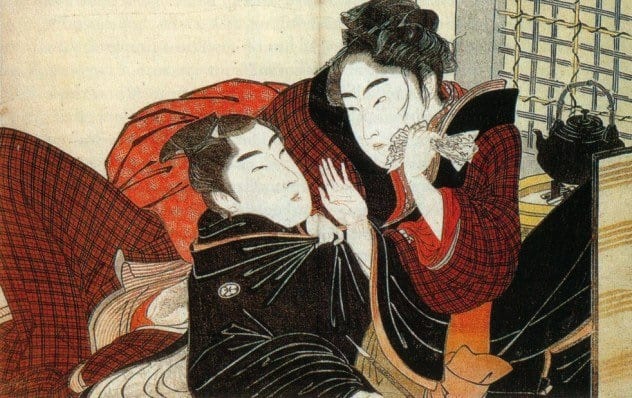 Mysteries
Mysteries  Mysteries
Mysteries  History
History 10 Surprising Stories About the Texas Rangers
 Humans
Humans 10 Philosophers Who Were Driven Mad by Their Own Theories
 Miscellaneous
Miscellaneous 10 Video-Game-Worthy Weapons and Armors from History
 Weird Stuff
Weird Stuff 10 Psychics Who Accurately Predicted Wartime Events
 The Arts
The Arts 10 Pieces of Art Inspired by a Broken Heart
 Health
Health 10 Science Fiction-Sounding New Medical Treatments
 History
History 10 Surprising Facts About the Father of Submarine Warfare
 Space
Space Ten Astonishing New Insights into Alien Worlds
 Weird Stuff
Weird Stuff 10 Bizarre Summer Solstice Rituals Still Practiced Today
 Mysteries
Mysteries Top 10 Haunting Facts About the Ghost Ship MV Alta
 History
History 10 Surprising Stories About the Texas Rangers
 Humans
Humans 10 Philosophers Who Were Driven Mad by Their Own Theories
Who's Behind Listverse?

Jamie Frater
Head Editor
Jamie founded Listverse due to an insatiable desire to share fascinating, obscure, and bizarre facts. He has been a guest speaker on numerous national radio and television stations and is a five time published author.
More About Us Miscellaneous
Miscellaneous 10 Video-Game-Worthy Weapons and Armors from History
 Weird Stuff
Weird Stuff 10 Psychics Who Accurately Predicted Wartime Events
 The Arts
The Arts 10 Pieces of Art Inspired by a Broken Heart
 Health
Health 10 Science Fiction-Sounding New Medical Treatments
 History
History 10 Surprising Facts About the Father of Submarine Warfare
 Space
Space Ten Astonishing New Insights into Alien Worlds
 Weird Stuff
Weird Stuff 10 Bizarre Summer Solstice Rituals Still Practiced Today
Top 10 Shocking Facts On The True Story Behind The Kamikaze
KAMIKAZE!!! Just quietly uttering the word will conjure up visions of terror and destruction on a fantastic scale, and of course a spectacular fiery explosion and death—the cockpit and the guy flying it. They have their own drink, the word is branded into the global conscience, and is no doubt used countless times every day around the planet, yet many don’t know the true story behind these brave, yet terrifying suicidal WWII warriors. The Germans used suicide attacks in WWII, but only sparingly when compared to their Axis counterparts in the Pacific. The Japanese on the other hand took finding ways to hit big steel things with big steel bombs to an entirely new level and degree of viscous savagery. Imagine such treachery as a suicidal mine-wielding frogman under your ship, or some guy in a huge rocket-powered bomb flying at you at 650 mph (1046 kph)! Please read on to find out which of these flew, which floated, and which didn’t. Here you can learn more than you might ever want to know about what the Allied forces and the rest of the world would come to know as the “kamikaze.” Prepare to be both amazed and shocked at the lengths these people went to, to try and win what would prove to be an unwinnable war.
10 Facts About The Kamikaze You Probably Didn’t Know
10 What Did “Kamikaze” Mean Back Then?
First, it helps to know the actual Japanese meaning of the word. Literally, as when reading, kamikaze would be read simply as “god-wind,” but it most commonly denotes the “divine wind,” which was the light in which the Japanese saw the kamikaze soldier in during World War II. The Japanese concept of the “divine wind” dates back in their culture to the Middle Ages when twice, invading fleets of Mongol warships were ravaged en route by typhoons, both times sparing the Japanese from spilling even a drop of blood in their defense. They called these miraculous events “divine wind,” and were taught about to every school age child in Japan, and in WWII, their hopes were that these kamikazes would be their new divine wind, that would again snatch them from the jaws of defeat.
In the West though, especially to Allied servicemen, the kamikazes were simply suicidal pilots or soldiers of the Imperial Japanese Empire, that viciously attacked Allied forces from the air, land, and sea, in the costliest, longest, and most horrific fighting of the entire war, with complete disregard for their own lives. It is interesting to note that a “divine wind,” this one named Typhoon Cobra, did manage to ravage the Allied Pacific Fleet, then commanded by Admiral William ‘Bull’ Halsey, on 14 December, 1944, on the way to attack the Japanese. This tropical maelstrom, dubbed “Halsey’s Typhoon,” took the lives of 790 seamen, and sank at least two destroyers in the Philippine Sea east of Luzon.
9 The Ancient Japanese Samurai And Their Bushido Code

The ancient samurai ideology, and their Bushido Code, was condensed in “Hagakure,” which was a collection of 18th-century samurai anecdotes and axioms that literally began with the sentence, “The way of the samurai lies in death…,” and so was clearly meant to enforce the belief that a soldier had to be ready to die for his emperor at all costs. This would soon become the core philosophy of the Japanese soldier who had already adopted the samurai ideology, thus subsequently adopting the Bushido philosophy reprinted in Hagakure as well. Although never reprinted in-full before the 1930s, that would change with war when a commentary, praising the logic in Hagakure’s message, was published in 1940, and given to every Japanese soldier to carry with him into battle. Today, military historians aren’t quite sure if the Japanese soldier’s failure to surrender was due to his belief in the samurai traditions and the Bushido Code, the fear of being executed by their own side for cowardice, or even by the “murderous” Americans who they were told would kill them as well if they were captured by them. Whatever the case may be, ancient samurai ideology and the Bushido Code, along the message they carried with them in Hagakure, obviously influenced the Japanese soldier of WWII in a deadly manner for all involved.
8 The Precursors To Kamikaze Strikes—Banzai Charges, Suicide Bombers, And Suicide Pilots
Long before 1944, when kamikazes started attacking Allied forces in earnest, the Japanese had already been fighting with suicidal kamikaze-like tactics. In Europe, where over five million German soldiers had surrendered to Allied forces, in the Pacific, that number was less than five percent, or not very many. Although the Allies weren’t ready for these vicious suicidal attacks, they were well aware of their foe’s suicidal tendencies in battle. For example, during the “island hopping” campaigns of the Pacific Theater, frontal “Banzai!” charges against entrenched Allied positions from waves of Japanese soldiers, and attacks by individual suicide bombers with satchel charges sent to take out tanks, weren’t unheard of, but these were seen then by the Allies as acts of desperation born out of the desperate situation they found themselves in.
In hindsight though, the Allies could have known that their enemies were potentially suicidal, since there was a deadly kamikaze-like strike as far back as 1941 that very few have heard of in Pearl Harbor. This engagement occurred when the U.S.S. Curtiss, the first American seaplane tender constructed specifically for this purpose, was hit just below her bridge by a Japanese suicide pilot while fighting off Japanese warplanes and even a midget submarine at one time, on 7 December, 1941. The incident, although isolated and not sanctioned by the Japanese navy, caused 54 casualties, including several deaths aboard the Curtiss. Please note that these types of unsolicited attacks by the Japanese were called “kesshi,” referring to when an individual makes a ‘dare-to-die’ decision.
(“Banzai” is a Japanese battle cry meaning, “May you have ten thousand years of long life!”)
7 Japanese Prime Minister Orders Tokkō Missions
As early as mid-1943, the Japanese brass knew that bombing targets with heavy warplanes was both inaccurate and extremely expensive. They also knew that due to misses, American bombers had to drop three or four times as many bombs needed to destroy an intended target, and they did not have those resources to turn onto Allied forces. So they had to improvise, and improvise they did, and came up with the concept of “one plane, one ship” with the pilot and plane together acting as a human-guided bomb.
But the concept needed to be proven first, so on 14 October, 1944, a Japanese Rear Admiral did just that. He got in his plane, took off, found the closest Allied ship, and rammed it. That Allied ship was the American aircraft carrier U.S.S. Franklin, and the Divine Wind—or Kamikaze—was re-born. And then the Allies would soon learn more than anyone that the “one plane, one ship” concept would not last for their enemy, since kamikaze warplanes would eventually attack the Allies in droves.
The new divine wind actually began to blow when Japanese Rear Admiral Kamito Kuroshime first proposed voluntary suicidal attacks in July 1943 called “tokkō,” or Divine Wind Special Attack Units, which were at first rebuffed by the rest of Imperial command. But as Japanese losses mounted, as they had in the battles of Coral Sea, Midway, and Guadalcanal, they were forced to rethink the idea. Tokkō was officially militarized when Japanese Prime Minister Hideki Tojō gave the order to start forming ‘special suicide missions.’ These missions would use much of the inventory in the Japanese arsenal, with a few more added, but warplanes, and their expendable pilots, were the kamikazes main weapon of choice. Zeros, Oscars, Vals, Kates, even Betty bombers and other crafts of many types were used in kamikaze suicide attacks.
Documents captured after the war revealed that the pilots were required to be volunteers so Emperor Hirohito had plausible deniability, and could not be charged with war crimes, since he could claim he knew nothing of the Tokkō tactics and strategies.
6 Bomb-Laden Midget-Submarines Called Kiaryu (Sea Dragon) and Koryo (Japanese Meaning Unknown)
At first the Kiaryu and Koryo were thought of as the conventional offensive weapons they were first conceived as, but later it was discovered that the torpedoes or other explosives packed into them, came equipped with a manual hair-trigger, proving conclusively that they were meant to be used tactically as only a kamikaze could—in suicidal attacks against Allied warships—making them nothing less than cousins to the kaiten, which were the human-guided, Type 93, suicide torpedoes. There was a variety of these weapons made, most starting life in the Japanese Navy’s midget submarine fleet, some of them the same type that participated in the attack on Sunday morning of 7 December, 1941, at Pearl Harbor. Ironically, a foreshadowing of what the horror would later come to in the Pacific Theater, had first occurred long before America even declared war on their newfound enemy, when the U.S.S. Curtiss was struck by a Japanese fighter in an intentional suicide attack, causing 54 casualties after being hit just below her bridge. There is not much information on the use of the Kiaryu and Koryo since they were apparently held back in large numbers in preparation for the inevitable Allied attack on the Japanese mainland. There are pictures of many of these crafts floating in docks in Japan ready to strike out against their enemies.
5 “Scubacidal Maniacs” Called Fukuryu (Crouching Dragon)
Imagine if you will, a 1940s era, suicidal frogman, or “fukuryu,” silently slipping into the murky sea. He carries a huge anti-shipping mine packed with high explosives, and a very long pole to attach it to. He swims stealthily down below a giant steel ship, invisible and submerged in the inky darkness, where he plans to detonate his death-dealing device; by standing on the bottom with it extended upwards on his pole, to sink the steel behemoth looming ominously above him. This is yet another potential horror story that the Allies would have dealt with, had they needed to invade Japan by conventional means as they had originally planned. After the end of the war, Japanese records indicated that they had 1,200 fukuryu suicidal frogmen trained, but that they had no mines for them when they surrendered. This lack of ordinance is thought to be due to their commanders not anticipating the atom bomb strikes, and the quick destruction of two of their major cities, and subsequent surrender aboard the U.S.S Missouri. Military historians feel that the these fanatical early suicidal scuba divers most certainly would have been armed had the Allies invaded, and may have caused considerable casualties and damage to ships at anchor.
4 Human-Guided, Cruise Missiles Called The Ohka (Cherry Blossom)
The kamikazes actually flew a bomb-laden, jet-powered, human-guided cruise missile, called the Ohka. The word is Japanese for “cherry blossom,” but they sure weren’t pretty. To Allied servicemen they were “bakas”, which is Japanese for “fool” (referring to their pilots, who they thought were “idiots”). These literally were flying human bombs with a rudimentary warplane built around them, and barely enough room for a pilot to sit and fly it into the nearest Allied ship he could find. They were propelled by three powerful rocket engines, and came in several models. They carried 550 pounds (250 kg) of high-explosives, and could fly as fast as 650 mph (1046 kph)! Most men on the ships they were targeting could barely even see them, let alone shoot at them. They were dropped from underneath the bellies of Betty bombers and came in just above the waterline so the ohkas were difficult enough to see as it was, but at these speeds they were almost impossible to hit with a cannon or machine gun, especially at such a low angle to the gunners up on the ships. Fortunately for the Allies the Betty motherships were big and slow and easily shot down by Allied fighters long before becoming a danger to Allied warships, although there is one reported sinking of an Allied warship by a “baka.”
3 Human-Guided, Anti-Aircraft Missiles Called The Taiatari (Body Strike)
By 1944, when the American B-29 Superfortress began pounding Japan from the air, the Japanese air forces were in tatters, but what they still had to work with was the “taiatari,” which was a stripped-down, Ki-44 single-seat, “Tojō” fighter plane. It was the most feared and heavily armed Japanese fighter of the Allied bomber crews, sporting two very dangerous 40-mm cannons. The taiatari may have been conceived with the German’s Sonderkommando Elbe in mind, which was a German fighter stripped of much of its weight, except for 60 rounds of ammunition to gain altitude in order to get high enough to physically ram Allied bombers in mid-air. The Japanese had the same thing in mind when they modified the Ki-44 Tojō in the same way to attack the B-29s over Japan. The idea was to get in close, get as many rounds off as accurately as possible, and then ram the nearest bomber they could find! Since the Japanese air force was so decimated by this time in the war, this tactic can only be viewed as a last ditch effort, and so obviously had little, if any effect on the Allied bombing campaign of the Japanese home islands.
2 Human-Guided Torpedoes Called The Kaiten (Return to Heaven)
Now imagine, you’re a Japanese “kaiten” pilot. It’s a gorgeous day in the South Pacific in August, 1944, as you climb up into your slender and sinister craft—a Type 93, “Long Lance” torpedo, with a cockpit carved out of the hull just big enough for you to be squeezed into. Your mission: First, get in the torpedo, then find the nearest Allied ship, and steer the giant bomb into it. “Piece of cake, right Joe?” You may find the concept anything but “simple,” but to the Japanese the kaitens were one of the most effective suicide weapons of WWII, second only to their kamikaze warplanes in effectiveness.
The Japanese Type 93 Long Lance was a very reliable and powerful, oxygen-propelled torpedo, that was 2 feet (61 cm) in diameter, just shy of 30 feet long (9 m), weighed 6 tons (2,721 kg), and carried a 1,080 pound (490 kg) warhead, with an effective range of 24,000 yards (22,000 m), at 59 mph (96 kph), around 52 knots—or as fast as a respectable family speedboat. After a rigorous training period involving a lot of dangerous diving (in which 15 trainees were killed), and maneuvering around an underwater obstacle course, these 17 to 28-year-old suicide pilots were, later in the war, literally locked inside their coffin so they couldn’t escape their horrific demise if even they wanted to. But then in later models the pilots were afforded a self-destruct mechanism, just in case their mission “failed.” Thank goodness for small favors, right?
1 Human-Guided, Bomb-Laden, Speedboats Called The Shin’yōs (Ocean Shaker)
Both the Japanese Navy and Army used suicide speedboats (called motorboats officially back then), and had several different versions, but with the same outcome in mind—destruction. The navy version of these human-guided, suicidal speedboat bombs had a crew of one (imagine that), and could reach speeds of close to 34 mph (55 kph), or 30 knots. They were equipped with a 660 pound (299 kg) charge installed in the bow, that was wired to blow at the flick of a switch should the pilot deem it necessary. These vessels also came equipped with two rocket launchers loaded with anti-ship ordinance for an added “punch.”
The army version was similar, and called the Maru-ni, but wasn’t a suicide weapon per se. The army’s idea was to run up close to an Allied ship, dump off one of your two depth charges, then turn around and run, hoping to escape the return fire that’s going to rain down on you, and/or the wave from the explosion rushing at you from behind, on the way out of danger. Having two depth charges onboard gives you twice the chances at succeeding at this harrowing activity. There apparently were reports of crewmen actually returning alive, but this was extremely dangerous at best, and most would think it suicidal to even consider it as anything but a suicide mission.
+ The Biggest And Baddest Battleship In Naval History Was Used As A Kamikaze
This warship was the pride and joy of both the Japanese Navy, and her people, and was named accordingly. The Yamato was named after the ancient Yamato State which was the name of first Japanese empire in their long and storied history. This battle wagon was one of just two on the planet that ever sported a set of nine Type 94, 18-inch naval rifles. These exquisitely engineered ginormous main guns had an effective range of 26 miles (74,029 km), and fired a 3,220 pound (1,460 kg) shell. All nine were quite capable of loading and shooting a projectile as heavy as a large car as far the eye can see and successfully hitting a target, making the Yamato a very formidable weapon—if used properly that is—if not, then you end up with 7 April 1945 and the results of Operation Ten-Go. Prior to this, the Japanese were so reluctant to use this ship, that she only fired shots in anger at her enemies once the entire war, and this was before Operation Ten-Go.
The Yamato and her sister ship, the Musashi, were the most powerful battleships ever to float, and the Musashi had already been lost at the Battle of Leyte Gulf in the Philippines over a year earlier. At 80,248 tons (36,476 kg) fully loaded, the Yamato class of battleships boasted nine of the Type 94, 18-inch (460 mm) naval rifles, which were the largest ever put to sea. Only two of the three ships in the class had these massive main naval guns, and one of them was on the bottom. Before Operation Ten-Go—the last Japanese offensive naval operation of WWII—but on this day in April 1945, she was being sent with her crew to be sacrificed in a kamikaze attack on Allied forces already fighting in Okinawa.
Operation Ten-Go turned into a complete disaster when the Japanese force was jumped by carrier-borne Allied fighters long before they were in position to attack. In a strong show of Allied air superiority, in the resulting deluge, Yamato, along with at least 3,700 of her crew, were lost to the sea when her powder magazine exploded. Several other Japanese ships were sunk, and many others were damaged. Sailors drowned, planes were destroyed, and their precious pilots lost, along with Japan’s ability to ever wage offensive warfare ever again in WWII.
Note: Operation Ten-Go is sometimes referred to as “Operation Heaven One.”
++ There “Would Be No Civilians In Japan”
A flyer nailed to a telegraph pole in Japan may have read, “ATTENTION! On 23 March, 1945, We, The Japanese Imperial Government, Have Passed THE VOLUNTEER ENLISTMENT LAW, requiring every Japanese male between the ages of 15 and 60, and every female between the ages of 15 and 40, to begin military training in the use of primitive weapons and suicidal tactics…,” This statement, or something like it posted by the Japanese government, in effect transformed Japan into an entire nation of kamikazes by “weaponizing” the bulk of the population, and no doubt contributed to the use of atomic weapons by the Allies to end the war.
Had they not developed the atomic bomb, Allied military leaders had already made plans to invade a country consisting almost completely of combatants, with the possibility of suicide bombers as young as 9 or 10 armed with satchel charges to blow up troops or tanks. Or at least that’s what the military feared, but then there is the passing of the Volunteer Enlistment Law, which militarized a huge proportion of the population, none of which would have had proper uniforms, and all of which would have blended in with the general population. This meant that the Allied soldiers on the ground wouldn’t have been able to tell civilian from combatant, so any Japanese would have been a potential kamikaze. It would have been the most gruesome guerrilla and urban warfare the world would have ever known.
10 Horrific Experiments Conducted By The Evil Japanese Unit 731








